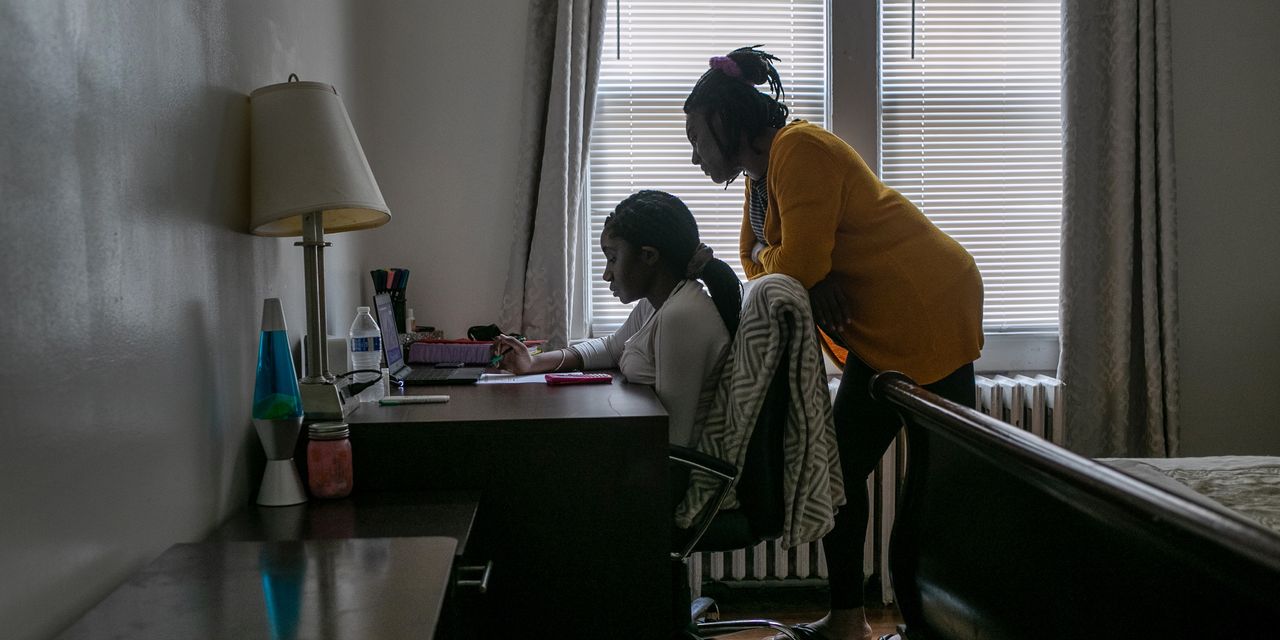
When the U.S. Centers for Disease Control and Prevention on Friday relaxed its guidelines on in-school instruction amid the pandemic, it framed the decision as a matter of science and public health.
Explaining the shift to an advised three-foot space between students — down from the previously recommended six-foot distance — CDC Director Rochelle Walensky said “these updated recommendations provide the evidence-based roadmap to help schools reopen safely, and remain open, for in-person instruction.”
The decision could clear the way for more schools to bring more students into classroom at a single time, according to some educators.
It might also give a financial lift to some parents of children who have been learning remotely, according to CDC data and the view of some experts.
“The economic disruption of school closures sharply impacts parents, and the new guidelines will likely encourage some sidelined employees to return to work in the coming months,” said Andrew Chamberlain, Glassdoor’s chief economist.
“Getting kids safely back into classrooms is one of the most important keys to our post-COVID-19 economic recovery, as the stresses of remote instruction are clearly depressing labor force participation for many.”
He added, “The latest CDC school guidelines allowing thousands of schools to re-open at reduced capacity for in-person classes will alleviate many American workers by providing much-needed child care.”
A day ahead of its updated K-12 school guidance, the CDC released a survey showing the toll of remote instruction. The survey looked at parents’ concerns about children’s physical and emotional well-being after months of remote instruction.
In addition, parents of children engaged in virtual instruction tended to be more worried about their own job stability and say they’ve lost work.
• Almost 43% of parents with kids receiving virtual instruction reported a loss of work versus the nearly 31% of parents with children having in-person instruction.
• More than a quarter (26.6%) had job stability concerns, versus the 15.2% of parents of children receiving in-person instruction.
• Almost 15% reported conflicts between work and offering child care. That’s about double the 8.3% of parents with children in school who said they had the same conflict.
• 40% of parents with children in hybrid school reported a loss of work compared to 30.6% of parents with children physically in school, the CDC survey said.
Most of the 1,290 parents used in the survey’s final sample sent their children to public schools. The survey was conducted between early October and early November — just as a surge in COVID-19 cases would make many schools turn to remote instruction at least over the holiday season.
By early November, 47.3% of school districts were using solely in-person instruction, according to research from the Center on Reinventing Public Education. Just over 20% used remote instruction, 15% relied on a mixed “hybrid” model and 16% said the approach varied, depending on the grade.
80% of schools now offer some form of in-person instruction, the American Federation of Teachers, a 1.7 million-member union, noted Friday.
The CDC’s survey didn’t delve into why parents with children learning virtually faced stronger financial headwinds. But raising children is time-consuming — even without a pandemic layering on job demands with kids constantly around, who may need help navigating online-learning platforms or Zoom ZM, +3.14% glitches.
“Whether you’re a frontline worker or working from home, many employees are rightfully concerned that remote learning is hurting their work productivity and potentially putting their job at risk,” Chamberlain said.
The consequences have been especially tough on mothers. Approximately 6 in 10 parents at home with children under age 18 say it’s been hard getting their work done without interruptions, according to Pew Research Center findings released in January.
57% of mother say work has become more difficult during the pandemic, compared to 47% of fathers who feel the same way. One-third of mothers at home said they had to reduce their work hours versus one-quarter of fathers, Pew researchers found.
After jobless rates surged to double-digit rates in the spring, they fell to 6.2% in February. But women still had 5.1 million fewer jobs last month than they did at the same point last year, while men had 4.4 million fewer jobs, according to the Institute for Women’s Policy Research.
The CDC guidance, which also calls for universal masking, is just guidance that does not guarantee more in-person instruction. Shifting from remote instruction to hybrid and in-person schooling are decisions that school district officials and teachers have to come to, mixing in parent views as well.
“No one wants to end remote and hybrid education more than educators, parents and students — just ask anyone who’s had to teach or learn with simultaneous online and in-person instruction,” said Randi Weingarten, AFT’s president.
“While we hope the CDC is right and these new studies convince the community that the most enduring safety standard of this pandemic — the 6-foot rule — can be jettisoned if we all wear masks, we will reserve judgment until we review them, especially as they apply in districts with high community spread and older buildings with ventilation challenges.”
Students need to be in school, and Weingarten said her union has pressed for that since last April. But the literature on reduced distancing, so far at least, “has been inconclusive at best and misleading at worst.”
“Let’s start working now to tackle the education, well-being and mitigation strategies needed to help schools reopen in the fall in a way that’s as close as ‘normal’ as possible, to help kids thrive,” she said.




